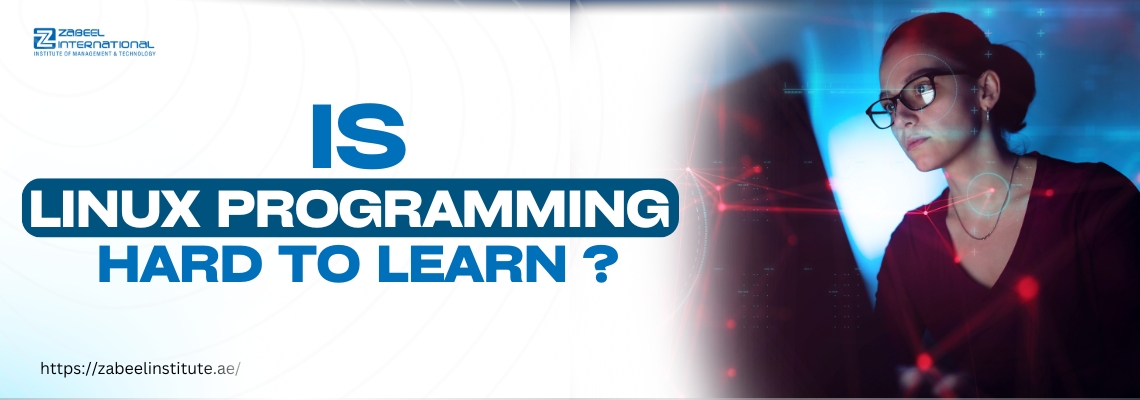Is Linux Programming Hard to Learn?
In today’s technology-driven world, Linux programming skills have emerged as a valuable asset for developers, system administrators, and cybersecurity professionals. As experts at Zabeel Institute, we frequently encounter this foundational question from prospective students: “Is Linux programming hard to learn?” This comprehensive analysis explores the learning curve, challenges, and strategies for mastering Linux programming, providing insights based on our extensive experience training professionals across various technical domains.
Understanding the Linux Programming Landscape
Before addressing the difficulty level, it’s essential to clarify what “Linux programming” encompasses, as the term can refer to several distinct concepts:
1.Shell Scripting and Command Line Development
- Writing bash, zsh, or other shell scripts
- Automating system administration tasks
- Creating command-line utilities
2.System Programming in Linux Environments
- Developing applications that interact with the Linux kernel
- Working with system calls and low-level interfaces
- Creating services and daemons
3.Application Development on Linux Platforms
- Building applications that run on Linux
- Using Linux-specific libraries and frameworks
- Cross-platform development considering Linux compatibility
4.Kernel Development
- Contributing to the Linux kernel itself
- Writing device drivers
- Implementing system-level functionality
- Each of these domains presents different learning challenges and complexity levels, making a nuanced assessment necessary.
Factors Influencing the Learning Curve
Several factors determine how difficult an individual might find learning Linux programming:
1.Prior Programming Experience
Previous experience significantly impacts the learning journey:
- Experienced Programmers: Developers familiar with other operating systems often find the transition to Linux programming relatively straightforward, primarily requiring adaptation to Linux-specific conventions and tools.
- Programming Newcomers: Those learning programming concurrently with Linux concepts face a steeper initial challenge but benefit from developing platform-native habits from the outset.
2.Technical Background and Mindset
Your technical foundation influences the learning process:
- Command Line Familiarity: Prior comfort with command-line interfaces significantly reduces the learning curve.
- Operating System Understanding: Knowledge of operating system concepts like processes, file systems, and permissions provides valuable context.
- Problem-Solving Approach: Linux rewards methodical troubleshooting and documentation-based learning, which aligns better with certain learning styles.
3.Learning Resources and Methodology
The quality and format of learning resources dramatically affect perceived difficulty:
- Self-Directed Learning: Requires strong motivation and discipline, with progress potentially slowed by knowledge gaps or misconceptions.
- Structured Education: A well-designed Linux programming course provides systematic skill building with expert guidance through complex concepts.
- Project-Based Learning: Practical application through meaningful projects reinforces theoretical knowledge and builds confidence.
4.Specific Linux Programming Domain
Different Linux programming areas present varying difficulty levels:
- Shell Scripting: Generally the most approachable entry point, with a gradual learning curve and immediate practical applications.
- System Programming: Requires deeper understanding of operating system concepts and memory management.
- Application Development: Varies widely depending on the complexity of the application and frameworks used.
- Kernel Development: Represents the most challenging domain, requiring extensive systems knowledge and C programming proficiency.
Common Challenges in Learning Linux Programming
Understanding specific obstacles helps in developing effective learning strategies:
1.The Command Line Interface
Many newcomers find the text-based interface intimidating:
- No Graphical Cues: Absence of visual elements requires memorization of commands and syntax.
- Terse Feedback: Error messages can be cryptic without experience interpreting them.
- Multiple Shells: Different shell environments (bash, zsh, fish) offer varying features and syntax.
2.Conceptual Density
Linux embodies sophisticated operating system principles:
- Unix Philosophy: The composable, “tools that do one thing well” approach requires a mental shift for those from other environments.
- Everything is a File: This fundamental Linux concept underpins system design but differs from other operating systems.
- Permission Model: Understanding users, groups, and the permission system presents a learning hurdle.
3.Diversity of Distributions
The variety of Linux distributions can confuse beginners:
- Package Management Differences: apt, yum, pacman, and other systems work differently.
- Directory Structure Variations: Subtle differences between distributions affect where resources are located.
- Configuration Approaches: System configuration methods vary across distributions.
4.Documentation Quality
Documentation quality varies significantly:
- Man Pages: These comprehensive reference documents prioritize completeness over beginner accessibility.
- Project-Specific Documentation: Quality and accessibility vary tremendously across projects.
- Assumed Knowledge: Many resources assume foundational knowledge that beginners may not possess.
Strategies for Effective Linux Programming Learning
Based on our experience training professionals at Zabeel Institute, we recommend these approaches to navigate the learning curve effectively:
1.Progressive Skill Development
Structure your learning path strategically:
- Begin with Shell Basics: Master navigation, file operations, and basic command syntax.
- Progress to Shell Scripting: Develop automation skills through scripting before tackling more complex programming.
- Introduce Programming Concepts Gradually: Start with higher-level languages before diving into system-level programming.
- Build Project Complexity Incrementally: Begin with simple scripts, gradually working toward more sophisticated applications.
2.Hands-On Practice
Practical application accelerates learning:
- Dedicated Development Environment: Establish a Linux environment (virtual machine, WSL, or dedicated system) for regular practice.
- Daily Usage: Incorporate Linux into your daily workflow to develop familiarity and confidence.
- Problem-Based Learning: Set specific challenges to solve using Linux programming skills.
- Project-Based Application: Create meaningful projects that require applying multiple concepts together.
3.Resource Utilization
Leverage diverse learning resources:
- Structured Courses: A comprehensive Linux programming course online provides systematic concept coverage and structured progression.
- Documentation Reading: Develop the skill of extracting information from man pages and technical documentation.
- Community Engagement: Participate in forums, chat channels, and local user groups.
- Open Source Contribution: Examine and contribute to existing projects to learn from real-world code.
4.Mental Model Development
Focus on building conceptual understanding:
- Process Visualization: Develop a mental picture of how processes, files, and resources interact.
- System Architecture Understanding: Learn how kernel, shell, and applications relate to each other.
- Pattern Recognition: Identify common patterns in commands, file locations, and configuration approaches.
The Reality of Learning Linux Programming
Based on our extensive experience at Zabeel Institute, we’ve observed that while Linux programming presents significant challenges, its difficulty is often overestimated:
1.Initial Perception vs. Reality
The perception of difficulty frequently exceeds the actual challenge:
- Intimidation Factor: The command line and technical terminology can initially intimidate newcomers.
- Rapid Initial Progress: Most learners experience surprisingly quick progress once past the initial familiarization phase.
- Transferable Concepts: Many Linux concepts transfer to other systems and programming environments.
2.Learning Timeline Expectations
Realistic timelines help manage expectations:
- Basic Proficiency: 2-4 weeks for fundamental command line operations and simple scripting.
- Intermediate Skills: 2-3 months for comfortable shell scripting and basic system interaction programming.
- Advanced Capabilities: 6-12 months for proficient system programming and sophisticated application development.
3.Return on Investment
The learning investment delivers significant value:
- Career Opportunities: Linux skills remain in high demand across multiple technology sectors.
- Problem-Solving Capability: Linux programming knowledge enhances general technical troubleshooting abilities.
- Versatility: Skills transfer across virtually all server environments and increasingly to embedded systems and cloud platforms.
How Zabeel Institute Approaches Linux Programming Education
Our experience teaching thousands of professionals has refined our educational approach:
1.Conceptual Foundation Building
We emphasize understanding over memorization:
- System Architecture Context: Providing the “big picture” of how Linux components interact.
- Principle-Based Teaching: Focusing on underlying principles rather than just commands.
- Conceptual Connections: Relating new concepts to existing knowledge.
2.Practical Application Focus
Our methodology centers on hands-on learning:
- Lab-Intensive Approach: Extensive practical exercises reinforce theoretical concepts.
- Real-World Scenarios: Projects based on actual industry challenges.
- Problem-Solving Emphasis: Developing troubleshooting skills alongside programming techniques.
3.Progressive Complexity
We structure learning paths that build confidence through graduated challenges:
- Foundational Skills Mastery: Ensuring core concepts are thoroughly understood before advancing.
- Guided Project Development: Instructor supervision for increasingly complex projects.
- Independent Challenge Tasks: Opportunities to apply skills to novel problems.
4.Community and Collaboration
We foster a supportive learning environment:
- Peer Learning Opportunities: Collaborative problem-solving accelerates understanding.
- Industry Mentor Access: Experienced professionals provide context and guidance.
- Community Resources: Introduction to Linux communities and ongoing support channels.
Specialized Learning Paths
Different career objectives benefit from tailored Linux programming learning approaches:
1.For System Administrators
Focusing on automation and system management:
- Shell Scripting Emphasis: Developing advanced scripting capabilities for system tasks.
- Configuration Management: Working with tools like Ansible, Puppet, or Chef.
- Monitoring and Maintenance: Developing custom tools for system health and performance.
2.For Application Developers
Concentrating on building applications in the Linux environment:
- Development Environment Mastery: Understanding compilers, build systems, and dependencies.
- Linux-Specific APIs: Working with system libraries and frameworks.
- Performance Optimization: Utilizing Linux-specific performance features.
3.For Security Professionals
Specializing in security aspects of Linux:
- Security Tool Development: Creating custom security utilities and scripts.
- Penetration Testing: Programming tools for vulnerability assessment.
- Secure System Programming: Implementing secure coding practices in the Linux environment.
Training Facility in UAE: Dubai, Sharjah
If you are looking for Linux Programming Training Course online or offline in Dubai , you are reading the right article. Zabeel Institute has designed the Best Linux Programming Training Course in Dubai.
This certification offered by Zabeel Institute stands out from other training in the market.
Our exam result and pass percentage at Zabeel Institute is very high, which is increasing daily under the trainer’s constant support and guidance. Zabeel Institute is well known for delivering several successful batches of Programming Courses. Zabeel ensures to help all students with all sorts of assistance for their brilliant performance in the exam.
This Institute, established in 1988, is a leading Educational and Training Institute for executives in Dubai. This Institute is by the KHDA and Ministry of Education UAE. We offers training programs to professionals from various industries like Airlines, Travel & Tourism, Engineering, Construction, Accounts and finance, Information Technology, Logistics, Languages, and Management. Zabeel’s career-specific courses are imparted through interactive teaching techniques, state-of-the-art technology, and experienced and highly qualified faculty.
More than 32 Years of Experience in training Professional Executives
- Achiever of many QUALITY AWARDS for training from 1988 till date
- Qualified & Certified Trainers
- Sophisticated lab with high-end machines and licensed software
- Certificates attested by the Ministry of Education, UAE
- Vast resource materials for reference and course materials
- Free online support for further assistance
- Free follow-up orientation seminars & workshops
- Integrated Training & Career Development Plan
Please visit the KHDA website to learn more about Zabeel :
https://www.khda.gov.ae/en/directory/training-Institutes-search-results/training-institute?id=156
Recommendation:
Zabeel Institute helps you get based on your education and experience and will further guide you to the certification.
To know more about these asana course fees, asana course exam costs, asana exam fees, certification, general certification costs, and more, please Contact Zabeel Institute!
Zabeel offers Linux Programming Training Course in Dubai,
For further information please contact:
Tel: 600 52 4448, 00971 4 3974905
WhatsApp number: +971 503068426
Email: mail@zabeelinstitue.ae
Website: www.zabeel-international.com
Facebook: https://www.facebook.com/zabeel.international/
LinkedIn: https://www.linkedin.com/school/5954667/
Twitter: https://twitter.com/zabeel_intl
Instagram: https://www.instagram.com/zabeel_international/
To know more about Linux Programming Training Course in UAE,
Conclusion:
While Linux programming can be challenging at first—especially for beginners—it’s very achievable with the right approach. Success depends on structured learning, hands-on practice, expert support, and persistence.
At Zabeel Institute, our specialized methods help professionals overcome common hurdles, making Linux programming a practical and rewarding skill for career growth.













Recent Comments